The changes may not sound like much, but the better-suspended V-Strom exhibits improved handling during quick transitions between paved corners or when tackling bumpy off-road obstacles. There’s also less forward and aft pitch when braking and accelerating aggressively. Preload settings for both front and rear suspension components can be adjusted, the rear with an easily located hand dial beneath the seat on the right side of the bike.
Suzuki engineers differentiated the Gladius-sourced engine in the Strom by revising intake camshafts. This version of the Gladius engine also boasts new pistons, rings and cylinders (with Suzuki Composite Electrochemical Material plating), and two iridium spark plugs each, and single instead of double valve springs — all conspiring to reduce frictional loss and increase fuel efficiency by a claimed 10%.
Suzuki asserts the modifications result in modest torque advantages on the low end of the rev range and a few more peak ponies on the higher end. I noticed during our trip that an indicated 70 mph has the 645cc V-Twin spinning at 5,000rpm, right in the heart of its improved torque curve which is very useful when riding off-road or when needing to pass four-wheel cagers. Aggressive canyon riders will gladly make use of the extra horsepower, keeping the engine spinning between 6,000 rpm and its 10,000-rpm redline.
The 15mm higher standard seat height (32.9”) of the 2012 Strom may be discouraging to short riders, but the new 650 Strom features a narrower seat design. Suzuki claims the reduced width retains an almost identical reach for planting feet on the ground. While I have no problem flat-footing the Strom, the seat-to-footpeg distance seemed somewhat cramped and I quickly exchanged the stock seat for the optional high seat and its increase of 20mm, elevating the seat to 33.6 inches. Still able to comfortably touch terra firma, the taller saddle lessened the amount of knee-bend, making freeway distance riding more tolerable. For riders with less inseam, there’s also a low seat that reduces seat height by 20mm to 32.1 inches. A selection of seat heights is nice, but I’d prefer one seat that includes built-in height adjustments like Triumph’s 800 Tigers. All three seats feature a new, non-slip covering and V-Strom embossing comparable to a quality aftermarket product.
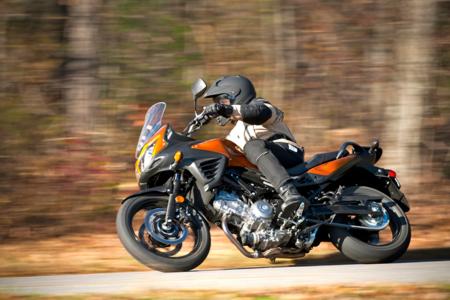 Better suspension settings and improved engine performance help a rider hustle the new V-Strom when the going gets fun. |
Also adjustable is the 2012 V-Strom’s windscreen. Unlike the easy-to-adjust windscreen on Kawaski’s Z1000, the V-Strom requires the removal of four bolts, repositioning the screen and re-torquing the bolts. Not a necessarily complicated process, however — including higher and lower bolt patterns isn’t a modern marvel — but it’s better than having no adjustability at all. I rode mostly behind the optional Vario Touring Windscreen ($370), and if long-distance wind comfort is a concern of yours’, I’d recommend considering this screen. Not sure if it was due to the 7-way adjustable spoiler, but this screen noticeably reduces air-pressure without inducing abnormal helmet buffeting.
In addition to the optional seats and touring screen, Suzuki focused on improving and expanding the available accessories for the 650 Strom including hand guards, heated grips, crash guards, power outlets, a centerstand and two different luggage systems. Improving on the previous model’s luggage system shouldn’t have been difficult and I can report the new system addresses past issues.
The Touring side cases and top box are constructed of a composite material with exterior latches and locks (the previous luggage’s was internal). Mounting brackets, while Erector Set in nature, provide a more custom fit to the bike and, more importantly, solidly and easily mounts the side cases. The same cannot be said about the top box. Riding sans earplugs down a Blue Ridge fire road, the jangling from the loosely mounted top box was made obvious. Otherwise, the new luggage system is a big improvement over the previous design.
Another luggage option exists in the form of aluminum construction. More rugged than its composite material counterpart, the aluminum cases and top box also feature exterior latches and locks, and use the same mounting brackets, only the mounting plates are specific to luggage type. Like the Touring bags, the aluminum cases and top box affix firmly to the bike, but some of the latches were loose fitting which rattled and raised some security concerns.
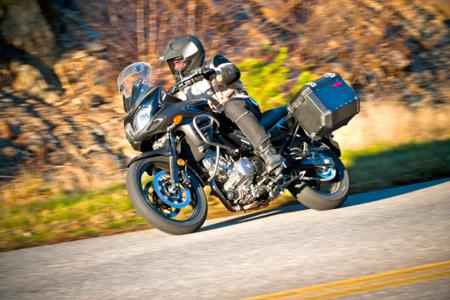 The V-Strom 650 ABS Adventure model is a factory-equipped upgrade, but it only comes in black. Adding the accessories to the standard model is an option, but it’ll cost more. |
The aluminum side cases come standard on the new V-Strom 650 ABS Adventure model (top box is optional). Available only in black, the V-Strom 650 ABS Adventure also comes equipped with the touring windscreen and crash bars for a retail price of $9800. Comparatively, the standard 650 ABS Strom does not include any accessories for a retail price $1500 less than the Adventure model, $8300.
Both models are equipped with a lighter version of the previous model’s ABS. Both also sport a restyled look that incorporates better air-flow — the combination of front fender and radiator shrouds working to increase cooling capacity while also directing hot air away from a rider’s feet.
In the rider cockpit, Suzuki redesigned the Strom’s instrumentation to include a digital speedometer and analog tach. New information includes a gear-position indicator, ambient air temperature and the backlight is adjustable for brightness. When the ambient air temperature reaches 32 degrees a frozen road warning indicator illuminates. The new gauge layout is practical and easy to read and an improvement over the previous model’s dual analog gauges.
Availability begins this month with Adventure models hitting dealer showroom floors by the end of November. Standard V-Strom 650 ABS models follow shortly behind coming to North American dealers in January, 2012.
For $8300, the standard V-Strom 650 is a solid deal, especially being equipped with ABS. Considering Suzuki managed to retain the qualities that have made the mid-displacement Strom a hit among motorcyclists while addressing its shortcomings and improving the design should maintain the model’s popularity. The time period for an improved Strom has been much longer than the annual iPhone upgrade, but like the gotta-have gadget, the revised Strom was worth the wait.
Related Reading
2012 Suzuki V-Strom 650 ABS Preview
2011 Suzuki V-Strom Review & 2012 Preview





 12:47 AM
12:47 AM
 Chiken Joe
Chiken Joe

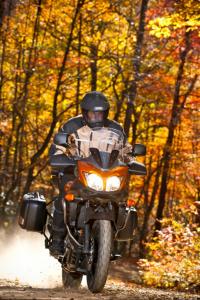
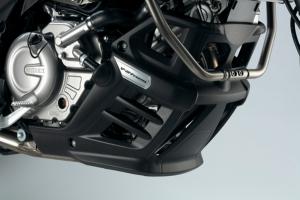
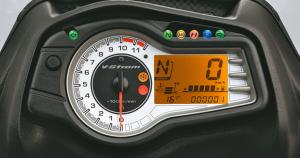




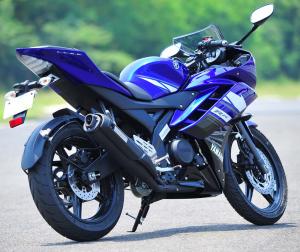 Among the many changes for 2012 is an R6-inspired LED tail-lamp.
Among the many changes for 2012 is an R6-inspired LED tail-lamp.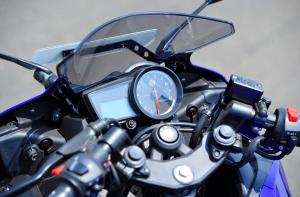
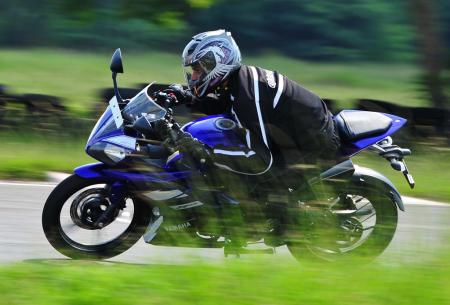 More responsive power is perhaps the most obvious improvement for 2012.
More responsive power is perhaps the most obvious improvement for 2012.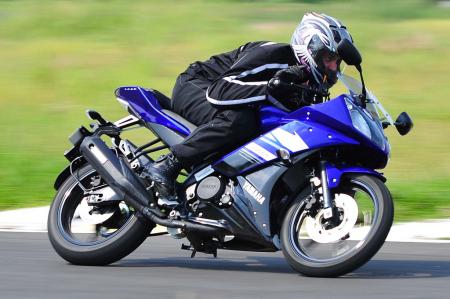 Confident handling, improved power delivery as well as incredible stability make the Yamaha R15 V2.0 a significantly better motorcycle to ride on a racetrack.
Confident handling, improved power delivery as well as incredible stability make the Yamaha R15 V2.0 a significantly better motorcycle to ride on a racetrack.






